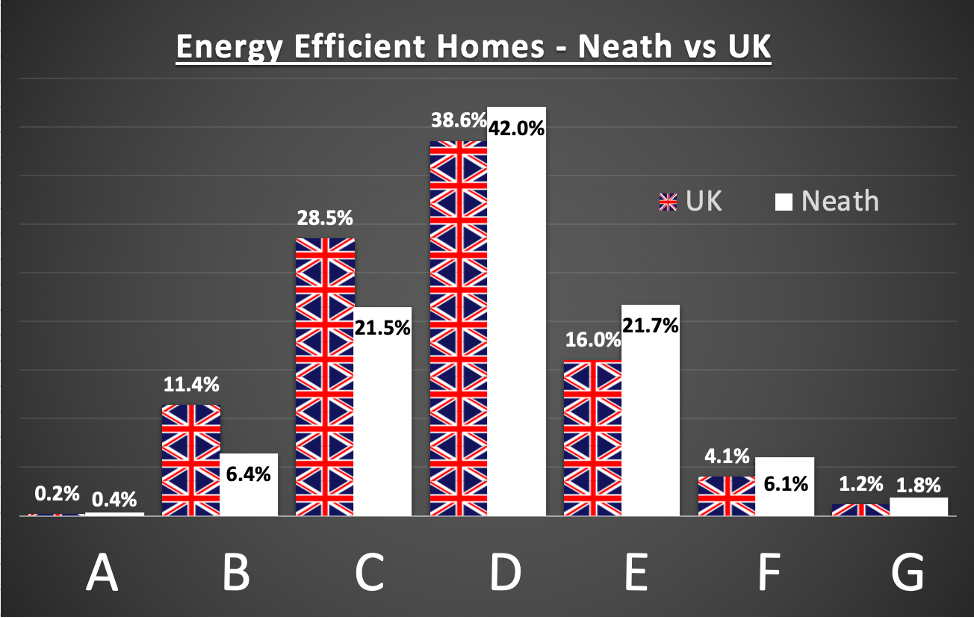

The energy bills of every Neath
resident will rise in April as the price cap increases to account for the
global increase in the cost of gas. Those not on the gas mains will still be
hit as the UK uses gas to make 45% of its electricity.
So, what can Neath residents do to
reduce their energy consumption and ultimately save money?
First, let’s look at the scale of the
costs.
Considering the increase in energy
prices from April, the combined energy bills for the whole of Neath come to…
- £34,603,192 for central heating
- £6,938,144 for hot water
- £3,770,517 for lighting


There are extra energy costs for
washing, fridges, etc., yet I wanted to focus just on the home as this is a
property blog.
Everyone’s bills will be around 50%
more expensive in 2022 than in 2021, but it’s not too late for Neath people
to take some quick steps to cut their energy bills and, at the same time, cut
our carbon footprint.
Just over a quarter of the UK’s carbon comes from heating and lighting our 27.6 million homes, and each UK home produces 4.39 tonnes of carbon dioxide a year.
Upgrading
the energy efficiency of UK homes is seen as a vital step to attempting to mitigate
the issues of climate change, fuel poverty and our nation’s energy security.
So, what
are some quick wins for Neath residents to reduce the energy bills on their
homes, and how will energy efficiency play a more significant part in the value
of Neath homes in the future?
- By turning down the thermostat by 1 degree, the average annual saving would be £105.91 per home and each homes carbon dioxide would be reduced by an eighth of a tonne (it all adds up!).
- Replacing your bulbs when you can with
energy-efficient bulbs will, on average, reduce your lighting costs from £172
per year to £103 per year.
- What time does your heating come on and off?
Could it come on later and go off earlier?
- Smart meters (which are installed for free) are
estimated to help lower UK homes electricity use by nearly 3% and gas use by 2%
… again it’s all margin gains.
These
are just a handful of ideas. Check out the internet for others as it’s
fascinating how much energy we use for overfull kettles, chargers left on and tech
on standby etc.
Yet,
these things will only scratch the surface… many of us will need to go further,
especially Neath landlords, to retrofit our properties to make them more
energy-efficient.
This is particularly
important as in June the Government announced they would make the country
carbon neutral by 2050, meaning Britain’s homes
need some enormous retro-fitting to meet these ambitious climate targets.
In
2018, the Government required private landlords to improve the energy rating of
their rental properties by prohibiting the rental of any property with an
Energy Performance Certificate (EPC) rating of F and G (the lowest ratings).
Yet from 2025, that will be increased to C for all new tenancies and 2028 for
all existing tenancies (more on these EPCs below).
I
don’t believe there is an appetite to mandate private homeowners to do this
work, though you never know in the future.


So, how do you find out about your Neath home’s eco-credentials?
Since 2007, every new home that has been built, rented
out or put on to the market in Neath has had to have an EPC, giving it a rating
between A and G (rather like those stickers you see on fridges and washing machines).
A is the highest rating (i.e., best energy efficient
and greener), and G is the worst efficiency rating.
28.3% of Neath homes are in that eco-friendly A to C energy
performance band rating, compared to the national average of 40.1%
So,
what next? Well, the Government will attempt to make the green revolution as
painless as possible with technology.
In the future, we might have hydrogen central heating
instead of mains gas; or have solar panels for electricity, all triple glazed
windows and even ground source heating – sounds fanciful? Well, who would have
thought some of the most wanted cars would be electric 20 years ago?
There is no doubt that the energy efficiency of our homes will
rise in the coming years as the cost of fuel increases and people’s opinion on
going green changes.
You don’t need to spend thousands of pounds to find out what
you can do to make your property greener and cost less. Look at your EPC and it
will tell you what small changes you can make to improve your Neath home’s
energy efficiency rating and ultimately save yourself money. If you want to
find the EPC rating of your Neath home, go to epcregister.com.
If you need an EPC, drop me a line as I know some great
local energy assessors that can easily do an EPC on your property at a price
that won’t cost the earth!




